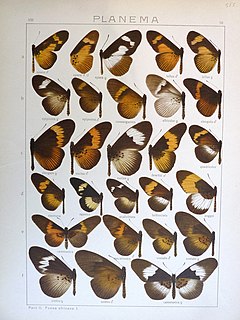The excised slitshell, scientific name †Gyrotoma excisa, was a species of freshwater snail, an aquatic gastropod mollusk in the family Pleuroceridae. This species was endemic to the United States. It is now extinct.
Manilkara excisa is an endangered species of tall tree in the sapodilla family. It is endemic to the extremely steep, forested limestone hills of Trelawny, Cockpit Country and St. James parishes in Jamaica, where, although it is highly prized for its wood, it is threatened by habitat loss.

Leucoblepsis excisa is a moth in the family Drepanidae first described by George Hampson in 1892. It is found in the north-eastern Himalayas, Peninsular Malaysia, Sumatra and Borneo. Records for Taiwan, refer to the species Leucoblepsis taiwanensis.

Bematistes excisa, the excised bematistes, is a butterfly in the family Nymphalidae. It is found in southern Nigeria, Cameroon, Bioko, Gabon, the Republic of the Congo and the western part of the Democratic Republic of the Congo. The habitat consists of forests with a dense understorey.
Adoxosia excisa is a moth of the subfamily Arctiinae. It is found in Brazil.
Pasiphila excisa is a moth in the family Geometridae. It was described by Arthur Gardiner Butler in 1878. It is found in Russia, Japan and Korea.
Diduga excisa is a moth of the family Erebidae. It is found in the Philippines.
Eugenia excisa is a species of plant in the family Myrtaceae. It is endemic to eastern Cuba.
Orphanostigma excisa is a moth in the family Crambidae. It was described by Edward L. Martin in 1956. It is found in Burundi, Cameroon, Malawi and Mozambique.
Ophyx excisa is a moth of the family Erebidae first described by Gustaaf Hulstaert in 1924. It is found in Papua, Indonesia. The habitat consists of hot lowland forests.

Pterolophia is a genus of longhorn beetles of the subfamily Lamiinae, containing the following species:
Amphitorna excisa is a moth in the family Drepanidae. It was described by William Warren in 1897. It is found in Borneo, Peninsular Malaysia and Sumatra.
Paranamera excisa is a species of beetle in the family Cerambycidae. It was described by Stephan von Breuning in 1942. It is known from Sumatra.
Niphona excisa is a species of beetle in the family Cerambycidae. It was described by Francis Polkinghorne Pascoe in 1862.
Pterolophia ingrata is a species of beetle in the family Cerambycidae. It was described by Francis Polkinghorne Pascoe in 1864.

Pterolophia melanura is a species of beetle in the family Cerambycidae. It was described by Francis Polkinghorne Pascoe in 1857. It has a wide distribution in Asia.
Pterolophia gibbosipennis is a species of beetle in the family Cerambycidae. It was described by Maurice Pic in 1926.
Pterolophia instabilis is a species of beetle in the family Cerambycidae. It was described by Per Olof Christopher Aurivillius in 1922. It is known from Seychelles.
Pterolophia guineensis is a species of beetle in the family Cerambycidae. It was described by James Thomson in 1864, originally under the genus Alyattes.


